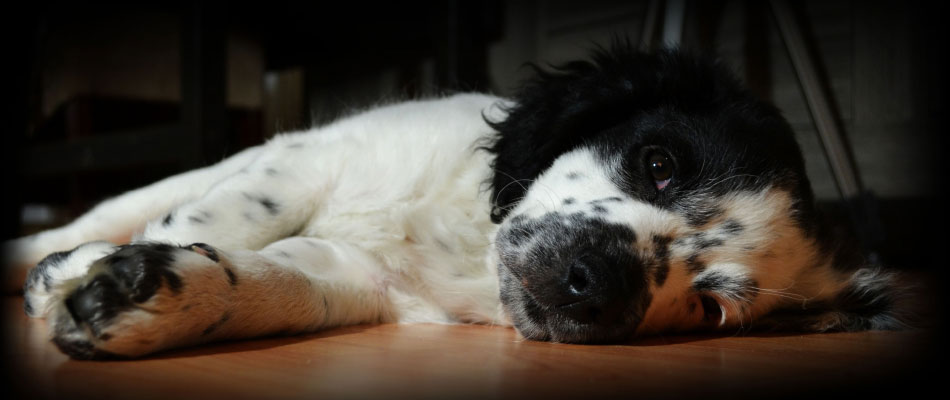07752 241 596 | wendy@furbabiesgrooming.co.uk


Here are some useful hints and tips to help you look after your pet properly.
Brushing Your Dog
Brushing is vitally important to help maintain a healthy coat. If your dog's coat is not brushed regularly it will soon become knotted and matted which may require the coat being shaved off completely.
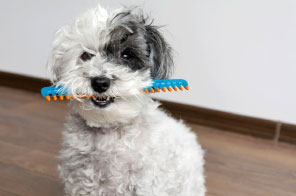
Just like when they go to the groomers your dog needs to know it's brush time. For example, the floor is the play area and the sofa is cuddle time... You therefore need to use an allocated space to signify brush time i.e. a table top or worktop space (a low table if you have a very tall dog). Place a rubber bath mat on the workspace and place the dog on the mat, to prevent them slipping, making sure there are no distractions. Speak soothingly and praise the dog whilst brushing for a few of minutes at a time. Repeat this process a couple of times a week always using the same allocated space. Your dog will soon learn that when it's on the rubber bath mat it's brush time.
The ideal technique to use for longer haired dogs is line brushing. This is a systematic way of effectively working the coat, right down to the skin. You should work evenly over your dog, holding or pushing up the coat with one hand while brushing through the fur. You should not move onto the next section until the brush stroke glides smoothly through the coat and the skin at the seam line can be seen. A comb can be used for double checking the work of the brush.
Exercising your Dog
Exercising your pet can be great fun and is important for their health and well-being.
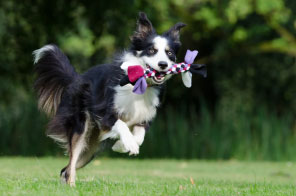
By law your dog must be wearing a collar and tag with your name and address on it when you take them outdoors. It's also a good idea to put your home or mobile phone number on the tag so you can be contacted immediately if your dog wanders off. It is also compulsory to get your dog microchipped and keep their details up to date. If the weather is hot you should walk your dog at the cooler times of the day, either first thing in the morning or in the early evening, as dogs' paws can burn on hot pavements. As a general rule, if it's too hot for your hand then it's too hot for their paws.
If the weather prevents you walking you can keep your dog mentally stimulated by doing some brain games, refresh their basic training with some sits and stays, or teach them new tricks. Dog swimming in the seaSwimming is excellent exercise for dogs and a great alternative to walking in the summer heat, but please remember, not all dogs like to swim. If yours doesn't then don't force them and never throw a dog into water.
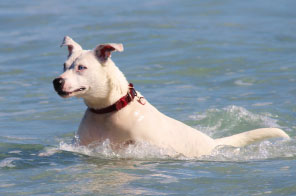
If you are visiting the beach beware of tides and do not let your dog drink salt water as it is likely to make them sick, bring fresh water with you. You should wash salt and sand off your dog's coat after swimming to prevent it drying and irritating their skin. Check freshwater lakes, rivers, ponds and canals to make sure they are clean and safe before letting your dog jump in. Some types of algae, including blue-green algae, are toxic to dogs. If your dog swims in algae-contaminated water, contact your vet immediately. Dogs can and do drown and if your dog has inhaled water, contact your vet as soon as possible, as dogs can suffer complications.
Preventing Heat Stroke
As temperatures rise, help keep your dog safe whilst having fun in the summer sun.
Dog wearing sunglassesDogs can suffer fatal heatstroke within minutes. Unlike humans, dogs can't sweat through their skin and rely on panting and releasing heat through their paw pads and nose to regulate their body temperature and keep cool.
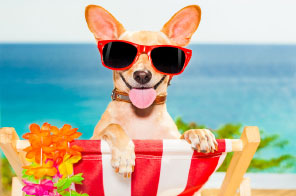
Imagine wearing a thick winter coat on a hot summer's day and you'll understand why dogs succumb to heatstroke so easily. Signs of heatstroke in dogs include collapse, excessive panting, and dribbling. If you suspect your pet is suffering from heatstroke, move them to a cool place, preferably with a draught, wet their coat with cool - not freezing - water, and contact your vet immediately. Once a dog shows signs of heatstroke the damage is often already done, which is why it's so important to prevent it. Make sure your dog has access to clean water at all times, ideally a large bowl filled to the brim. Carry water and a bowl with you on walks. On hot days, walk your dog during the cooler parts of the day, in the early morning and late evening.
Watch your pet for signs of over-heating, including heavy panting and loss of energy. If you recognise these signs when on a walk, stop, find a shady spot and give your dog water. NEVER leave your dog (or any pet) alone in a car, even with the windows open.
Keeping Your Pet Warm
As winter draws in and temperatures fall make sure you keep you furbabies warm. Dog wrapped in a blanketGenerally dogs are just as sensitive as people to a drop in temperature.
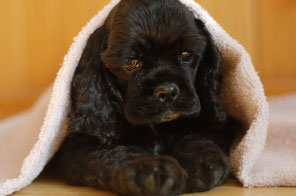
If the outside temperature falls below 10°C, puppies and small to medium-sized dogs begin to feel the cold whereas larger dogs can tolerate temperatures down to 5°C. Some dogs are more sensitive to the cold than others and this usually depends on the thickness and length of your dog's coat, their age, health, and weight. Temperature tolerance will vary with every dog, so it's important to learn the signs of drops in temperature which can lead to hypothermia.
Hypothermia occurs when your furbabie's body temperature falls below 35 to 37°C. A dog's normal body temperature is higher than for humans so they should be around 38 to 39°C. For healthy dogs with a long coat, if their hair gets wet and matted, their thick fur will offer less warmth and protection. Frostbite may also occur if your dog gets too cold. This happens when the body redirects blood flow to the most important parts of the body, often leaving the tail, ears, nose, paws, and legs at risk. Look for bright red or black colouring on any of these parts of the body.
A dog can also catch a cold from being too cold. Being in the cold won't actually give your dog a cold, but being exposed to uncomfortable conditions can create the perfect conditions for germs to latch on to your dog. For dogs, the symptoms can be sneezing, weakness, and nose/eye discharg
Spotting Signs of Stress
Learn how to understand what situations can cause anxiety in your furbaby.
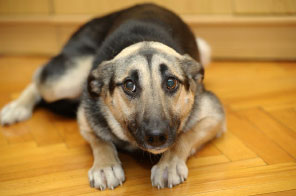
Dog cowering on the floorYou know your pet better than anybody and will often notice changes in their behaviour during stressful situations. Here are some simple things that you can do to help your pet when they are stressed. Keep cats indoors. Move cats and dogs to a blackened room in the evening where there are toys (the darkened room helps reduce problems from flashing lights). Try to engage your dog in an active game and using some background music will help to distract them. Try to ignore fearful behaviour and do not reassure them as this will only reinforce your dog's fearful behaviour. Your vet will be able to assess your pet and advise on suitable treatments and/or ways in which you can help to reduce the stress, such as fitting an Anxiety/Thunder Coat.
There are many situations that can make you furbaby anxious. Some of the most common events which many pets find extremely stressful are:
- Moving house
- Thunder and lightning
- Fireworks
- Load noises
- New members to the household (e.g. another pet or a baby)
- Multi-pet households
- Kennel or cattery stays
- Visits to the vet
- Another cat moving into the territory
During the firework season, many pets become stressed and fearful and the signs to look out for, in any stressful situation, include:
- Trembling and shaking
- Clinging to owners
- Cowering and hiding behind furniture
- Barking or meowing excessively
- Trying to run away
- Soiling the house
- Refusing to eat
- Pacing and panting

